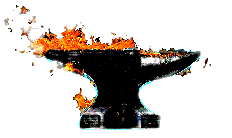To calculate the force to punch holes in metal you determine the cross section in shear and multiply it by the shear strength of the metal. The formula is Perimeter times thickness times shear. For round holes in steel this is Diameter * PI * 30. Thirty tons being the approximate shear strength of mild steel plus an allowance for friction. Tons are used to aid in press selection and rating. The practical limit for depth of punching cold is the diameter of the hole. | ||||||||||||||||||||||||||||||||||||||||||||||||||||||||||||||||||||||||||||||||||||||||||||||||||||||||||||||||||||||||||||||||||||||||||||||||||||||||||||||||||||||||||||||||||||||||||||||||||||||||||||||||||||||||||||||||||||||||||||||||||||||||||||||||||||||||||||||||||||||||
|
|

Home Copyright ©2004 Jock Dempsey, DEMPSEY'S FORGE | |||||||||||||||||||||||||||||||||||||||||||||||||||||||||||||||||||||||||||||||||||||||||||||||||||||||||||||||||||||||||||||||||||||||||||||||||||||||||||||||||||||||||||||||||||||||||||||||||||||||||||||||||||||||||||||||||||||||||||||||||||||||||||||||||||||||||||||||||||||||